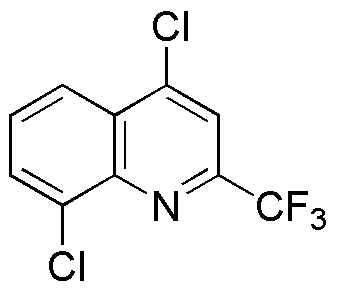4,8-Dichloro-2-(trifluoromethyl)quinoline is widely utilized in research focused on:
- Pharmaceutical Development: This compound serves as a key intermediate in the synthesis of various pharmaceuticals, particularly in developing anti-infective agents and anti-cancer drugs, enhancing therapeutic options.
- Agricultural Chemicals: It is used in formulating agrochemicals, including herbicides and fungicides, providing effective solutions for pest control while minimizing environmental impact.
- Material Science: The compound is explored for its potential in creating advanced materials, such as polymers and coatings, which exhibit enhanced durability and resistance to degradation.
- Analytical Chemistry: It acts as a reference standard in analytical labs for the detection and quantification of related compounds, ensuring accuracy in research and quality control processes.
- Biochemical Research: Researchers utilize this compound to study its interaction with biological systems, aiding in the understanding of disease mechanisms and the development of targeted therapies.
Información general
Propiedades
Seguridad y normativas
Aplicaciones
4,8-Dichloro-2-(trifluoromethyl)quinoline is widely utilized in research focused on:
- Pharmaceutical Development: This compound serves as a key intermediate in the synthesis of various pharmaceuticals, particularly in developing anti-infective agents and anti-cancer drugs, enhancing therapeutic options.
- Agricultural Chemicals: It is used in formulating agrochemicals, including herbicides and fungicides, providing effective solutions for pest control while minimizing environmental impact.
- Material Science: The compound is explored for its potential in creating advanced materials, such as polymers and coatings, which exhibit enhanced durability and resistance to degradation.
- Analytical Chemistry: It acts as a reference standard in analytical labs for the detection and quantification of related compounds, ensuring accuracy in research and quality control processes.
- Biochemical Research: Researchers utilize this compound to study its interaction with biological systems, aiding in the understanding of disease mechanisms and the development of targeted therapies.
Documentos
Hojas de datos de seguridad (HDS)
La SDS proporciona información de seguridad completa sobre la manipulación, el almacenamiento y la eliminación del producto.
Especificación del producto (PS)
La PS proporciona un desglose completo de las propiedades del producto, incluida la composición química, el estado físico, la pureza y los requisitos de almacenamiento. También detalla los rangos de calidad aceptables y las aplicaciones previstas del producto.
Certificados de análisis (COA)
Busque certificados de análisis (COA) ingresando el número de lote del producto. Los números de lote y de partida se pueden encontrar en la etiqueta de un producto después de las palabras "Lote" o "Lote".
Número de catálogo
Número de lote/lote
Certificados de origen (COO)
Este certificado de origen confirma el país en el que se fabricó el producto y también detalla los materiales y componentes utilizados en él y si se deriva de fuentes naturales, sintéticas u otras fuentes específicas. Este certificado puede ser necesario para cumplir con las normativas aduaneras, comerciales y regulatorias.
Número de catálogo
Número de lote/lote
Hojas de datos de seguridad (HDS)
La SDS proporciona información de seguridad completa sobre la manipulación, el almacenamiento y la eliminación del producto.
DownloadEspecificación del producto (PS)
La PS proporciona un desglose completo de las propiedades del producto, incluida la composición química, el estado físico, la pureza y los requisitos de almacenamiento. También detalla los rangos de calidad aceptables y las aplicaciones previstas del producto.
DownloadCertificados de análisis (COA)
Busque certificados de análisis (COA) ingresando el número de lote del producto. Los números de lote y de partida se pueden encontrar en la etiqueta de un producto después de las palabras "Lote" o "Lote".
Número de catálogo
Número de lote/lote
Certificados de origen (COO)
Este certificado de origen confirma el país en el que se fabricó el producto y también detalla los materiales y componentes utilizados en él y si se deriva de fuentes naturales, sintéticas u otras fuentes específicas. Este certificado puede ser necesario para cumplir con las normativas aduaneras, comerciales y regulatorias.


